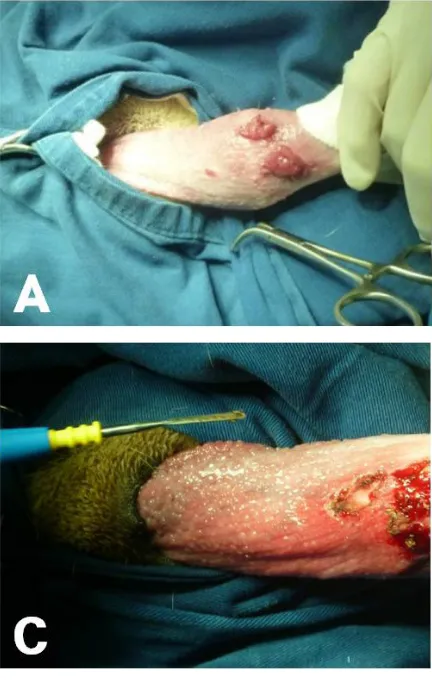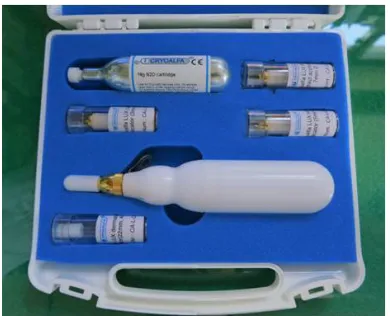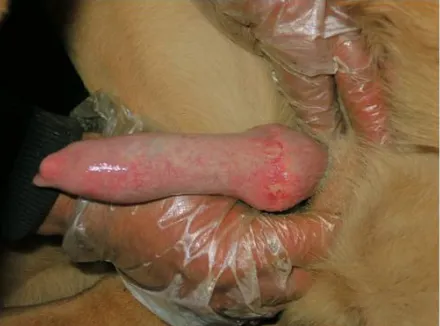Cryosurgery and electrocautery in treatment
of transmissible venereal tumours in large breed dogs:
a case report
S.J. Choi
1, D.B. Lee
2, N.S. Kim
21Chois animal hospital, Seoul, Republic of Korea
2Chonbuk National University, Jeonju, Republic of Korea
ABSTRACT: Five intact male group-raised Tosa dogs were diagnosed with transmissible venereal tumours. Surgi-cal removal with electrocautery and a cryogun was conducted because the owner wanted to maintain the fertility of the dogs. The dogs were followed up for 12 months. The surgical wounds were completely healed by five to six weeks. The dogs remained fertile without complications or recurrences. To maintain fertility in dogs suffering from transmissible venereal tumours, the combination of an electrocautery and a cryogun is suggested.
Keywords: cryogun; fertility; male dogs
A transmissible venereal tumour (TVT) is a his-tiocytic tumour that can be transmitted among dogs and other canids through coitus, licking, biting, and sniffing tumour affected areas (MacEwen 2001). TVTs are also known as transmissible venereal sarcomas, sticker tumours, venereal granulomas, canine condylomas, or infectious sarcomas. TVTs are mostly observed in free-roaming, sexually active dogs in tropical and subtropical regions such as the southern US, Central and South America, southeast Europe, Ireland, Japan, and China (Eze et al. 2007).
Dogs with TVTs experience pain, haemorrhages and exhibit serosanguineous discharge in the ex-ternal genitalia (MacEwen 2001). TVTs are usually cauliflower-like in appearance, friable, and red to flesh coloured (MacEwen 2001). A TVT can be de-tected in the nasal cavity, oral cavity, skin, sclera, or the anterior chamber (MacEwen 2001). Metastases have been reported in 5–17% of cases (Richardson 1981; Rogers et al. 1998).
Several treatments including surgery, radiothera-py, and chemotherapy have been used to treat TVTs (MacEwen 2001). Surgery has been used extensively to treat small, localised TVTs, although the recurrence rate can be as high as 50–68% in cases of large invasive tumours. Radiotherapy is also effective against TVTs but necessitates specialised equipment and
immobili-sation of the dog during radiotherapy (Boscos 1988). Chemotherapy using antimitotic agents such as cyclo-phosphamide, methotrexate, vincristine, vinblastine, and doxorubicin is the most effective TVT treatment (Das et al. 1991; Das and Das 2000). However, dogs occasionally develop complications such as vomit-ing, diarrhoea and leucocytopenia. In addition, some antimitotic agents can induce decreased fertility in male dogs (Rosenthal 1981).
In this study, we describe five male dogs with TVT that were treated using electrocautery and cryosurgery to maintain their fertility.
Case description
pedicu-lated, and cauliflower-like. Round to oval cells with an eosinophlic thin cytoplasm were the main obser-vations on the cytological examination. Nuclei were dense and vacuoles were present in the cytoplasm. The nodules were diagnosed as TVTs.
Surgical resection of the tumours was conducted. Anaesthesia was induced with 6 mg/kg propofol and maintained with 2–3% isoflurane and oxygen after tracheal tube intubation. Antibiotic (20 mg/kg cefazolin i.v.) and analgesic (5 mg/kg tramadol i.m.)
were administered. An aseptic surgical field was prepared with a povidone wash. A liquid nitrogen cryogun was prepared to remove the small nod-ules and remnants completely (Figure 2; Cryoalfa-system®, Basel, Switzerland). The large nodules were held using haemostatic forceps and cut using an electric cautery (Figure 3A), which was also used to control haemorrhaging. The remnants in the are-as around the lesions were intensively frozen, while scattered or fused small nodules were frozen
exten-Table 1. Characteristics of the cases
Sex Body weight (kg) Number of nodules Location of nodules
Dog 1
intact male
115 fused small nodules2 large nodules penis bodycrus penis
Dog 2 117 scattered small nodules7 large nodules penis bodycrus penis
Dog 3 118 scattered small nodules2 large nodules penis body – crus penisglans penis
Dog 4 124 scattered small nodules4 large nodules glans penis – penis bodycrus penis
[image:2.595.63.534.102.261.2]Dog 5 130 scattered small nodules13 large nodules glans penis – crus penispenis body – crus penis
[image:2.595.68.284.421.762.2]sively for 20 s using a cryogun (Figure 3B). The sur-gical wounds were flushed with sterile saline after the nodules were removed. Postoperative antibiotic (20 mg/kg cefazolin p.o.) and analgesic (5 mg/kg tramadol p.o.) were administered for five days.
The dogs were presented for follow-up 12 months after the surgery. The clinical symptoms of all dogs were eliminated, and the surgical wounds healed completely by five to six weeks after sur-gery (Figure 4). All dogs had regained fertility by Week 7 after the surgery. There were no recur-rences or metastases during the follow-up period.
DISCUSSION AND CONCLUSIONS
TVTs can occur in any breed, age, and sex of dog but it frequently occurs in dogs two to five years old (Das et al. 1991). TVT is most common dur-ing the period of maximum sexual activity in dogs (Das and Das 2000). All dogs in this study were used for commercial breeding. TVT may have been
transmitted easily by these dogs because they were a group raised in a closed environment.
Chemotherapy is the most effective TVT treat-ment (MacEwen 2001), and vincristine is frequently the agent of choice (MacEwen 2001). When tumours do not respond to vincristine, a combination with other agents such as l-asparaginase, cyclophos-phamide, methotrexate, and doxorubicin can yield satisfactory results (Kim et al. 1996; Pansawut et al. 2012; Javanbakht et al. 2014). However, single-agent therapy with two to five treatments of vincristine (0.025 mg/kg) at weekly intervals is the most effec-tive treatment (Amber et al. 1990). Chemotherapy with vincristine is desirable for TVT treatment be-cause it results in a good prognosis without serious complications. However, the owner in our case re-fused chemotherapy because he wanted to maintain the fertility of the dogs.
[image:3.595.85.280.83.241.2]Cytotoxic agents can alter spermatogenesis temporarily or permanently (Rosenthal 1981). Vincristine can cause cytoplasmic protein precipi-tation, which, in turn, interferes with microtubule formation (Rosenthal 1981). Vincristine can dam-age germ cell DNA, thereby reducing the rate of development of these cells (Zhang and Sun 1992). It is known that vincristine is associated with the risk of infertility in humans (Lee et al. 2006). However, Gobello and Corrada (2002) reported that vincris-tine administration does not alter libido, testicular size, or semen parameters in male dogs with genital TVT. The cause of this discrepancy is not clear. Further studies on the effect of vincristine on sper-matogenesis should be conducted, but we cannot completely rule out the possibility that vincristine alters fertility in male dogs. Therefore, we decided to perform cryosurgery of the tumours rather than chemotherapy to maintain the fertility of the dogs.
[image:3.595.78.521.573.739.2]TVTs are easily transplanted to surgical wounds during surgical removal of tumours, including en bloc excision and debulking, and recurrence is 12–68% for cases of TVT (Idowu 1984; Dass and Sahay 1989; Pandey et al. 1989; Gandotra and Chauhan 1993). Thus, removing TVTs using elec-trocautery and/or a cryogun is desirable (Das and Das 2000; Savadkoohi et al. 2013). Electrosurgical removal is widely used in veterinary clinics and provides improved haemostasis. However, it leads to greater postoperative pain due to the thermal injury (Gloster 2000). In this study, we used an elec-trocautery to remove the large nodules, but not the small ones. The small nodules were extensively scattered mainly in the crus penis. Applying elec-trocautery to small nodules may cause severe wide-spread pain. Therefore, we used a cryogun instead of electrocautery to remove the small nodules.
Cryosurgery can be used to reduce tumour re-currence, as it induces direct cellular death and vascular collapse, leading to tumour elimination (Withrow 2001). It is a very effective treatment for solid tumours of the eyelid, perianal, oral, skin, and others (Withrow 2001). De Queiroz et al. (2008) successfully treated benign and malignant cutane-ous tumours by cryosurgical ablation with very low recurrence. We successfully removed small nod-ules and remnants using a cryogun. In particular, a cryogun was effective for removing the scattered nodules in a short time. These advantages can re-lieve the pain induced by tumour removal and allow rapid recovery of fertility.
In conclusion, we treated TVTs in male dogs with electrocautery and cryosurgery instead of chemother-apy to maintain the fertility of the dogs. The combina-tion of electocautery and cryosurgery was efficacious, cost-effective, and convenient and there were no
com-plications or recurrence. This method can be used as an alternative for the treatment of TVTs.
REFERENCES
Amber EI, Henderson RA, Adeyanju JB, Gyang EO (1990): Single-drug chemotherapy of canine transmis-sible venereal tumor with cyclophosphamide, metho-trexate, or vincristine. Journal of Veterinary Internal Medicine 4, 144–147.
Boscos C (1988): Transmissible venereal tumour in the dog: Clinical observations and treatment. Animalis Familiaris 3, 10–15.
Das U, Das AK (2000): Review of canine transmissible venereal sarcoma. Veterinary Research Communica-tions 24, 545–556.
Das U, Das AK, Das D, Das BB (1991): Clinical report on the efficacy of chemotherapy in canine transmissible venereal sarcoma. Indian Veterinary Journal 68, 249–252. Dass Ll, Sahay PN (1989): Surgical treatment of canine
transmissible venereal tumour – a retrospective study. Indian Veterinary Journal 66, 255–258.
De Queiroz GF, Matera JM, Zaidan Dagli ML (2008): Clinical study of cryosurgery efficacy in the treatment of skin and subcutaneous tumors in dogs and cats. Veterinary Surgery 37, 438–443.
Eze CA, Anyanwu HC, Kene ROC (2007): Review of ca-nine transmissible venereal tumour(tvt) in dogs. Ni-gerian Veterinary Journal 28, 54–70.
Gandotra VK, Chauhan FS (1993): Occurrence of canine transmissible venereal tumour and evaluation of two treatments. Indian Veterinary Journal 70, 854–857. Gloster HM, Jr. (2000): The surgical management of
ex-tensive cases of acne keloidalis nuchae. Archives of Dermatology 136, 1376–1379.
Gobello C, Corrada Y (2002): Effects of vincristine treat-ment on semen quality in a dog with a transmissible venereal tumour. Journal of Small Animal Practice 43, 416–417.
Idowu Al (1984): A retrospective evaluation of four sur-gical methods of treating canine transmissible venereal tumour. Journal of Small Animal Practice 25, 191–198. Javanbakht J, Pedram B, Taheriyan MR, Khadivar F, Hos-seini SH, Abdi FS, HosHos-seini E, Moloudizargari M, Aghajanshakeri SH, Javaherypour S, Shafiee R, Emrani Bidi R (2014): Canine transmissible venereal tumor and seminoma: A cytohistopathology and chemotherapy study of tumors in the growth phase and during regres-sion after chemotherapy. Tumour Biology 35, 5493–5500. Kim JM, Yang HK, Shin TY, Kweon OK, Nam TC (1996):
[image:4.595.68.288.86.249.2]tumor in a dog. Korean Journal of Veterinary Clinic Medicine 13, 212–215.
Lee SJ, Schover LR, Partridge AH, Patrizio P, Wallace WH, Hagerty K, Beck LN, Brennan LV, Oktay K (2006): American society of clinical oncology recommenda-tions on fertility preservation in cancer patients. Jour-nal of Clinical Oncology 24, 2917–2931.
MacEwen EG (2001): Transmissible venereal tumour. In: Withrow SJ, MacEwen EG (eds.): Small Animal Clini-cal Oncology. 3rd ed. Saunders, Philadelphia. 651–656. Pandey SK, Chandpuria VP, Bhargava MK, Tiwari SK
(1989): Incidence, treatment, approach and metastasis of canine transmissible venereal sarcoma. Indian Jour-nal of Animal Sciences 59, 510–513.
Pansawut S, Patrakrit T, Sirichai T, Suppawiwat PCK (2012): Treatment of canine transmissible venereal tumor using vincristine sulfate combined with l-as-paraginase in clinical vincristine-resistant cases: A case report. Thai Journal of Veterinary Medicine 42, 117–122.
Richardson RC (1981): Canine transmissible venereal tumor. Compendium on Continuing Education for the Practicing Veterinarian 3, 951–956.
Rogers KS, Walker MA, Dillon HB (1998): Transmissible venereal tumor: A retrospective study of 29 cases. Journal of the American Animal Hospital Association 34, 463–470.
Rosenthal RC (1981): Clinical application of vinea alka-loids. Journal of American Veterinary Medical Asso-ciation 179, 1084–1086.
Savadkoohi HS, Dehghani SN, Namazi F, Khafi MA, Jalali Y (2013): Electrosurgical excision of a large uniform transmissible venereal tumor (tvt) in a spayed bitch: A case report. Journal of Animal and Poultry Sciences 2, 60–64.
Withrow SJ (2001): Alternative treatments for solid tu-mors. In: Withrow SJ, MacEwen EG (eds.): Small Animal Clinical Oncology. 3rd ed. Saunders,
Philadel-phia. 77–91.
Zhang Y, Sun K (1992): Unscheduled DNA synthesis induced by the antitumor drug vincristine in germ cells of male mice. Mutation Research 281, 25–29.
Received: 2014–04–18 Accepted after corrections: 2014–10–12
Corresponding Author:
Nam-soo Kim, DVM, PhD, Chonbuk National University, Department of Veterinary Surgery, Dukjin-dong 664-14, Dukjin-ku, Jeonju 561-756, Korea


